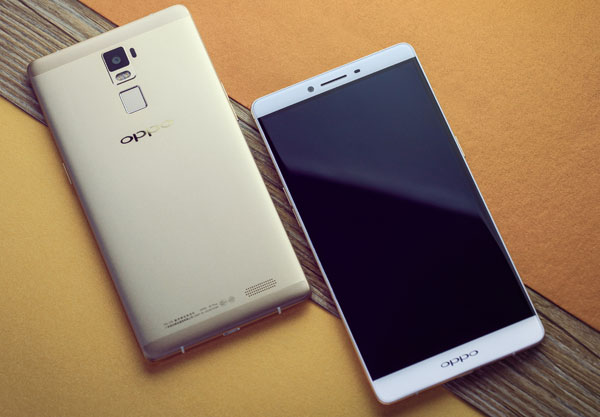
The Oppo R7 Plus continues Oppo’s trend of making somewhat iPhone-esque designs work at a price point considerably below that of Apple’s premium designs.
I’ve commented previously on Oppo’s pitch to the Australian market seemingly centering on phones that look not exactly like, but very close to Apple’s iPhone designs. Leaving the lawyering out of it, it’s sensible business given the very strong love affair that Australian consumers seem to have with Apple’s brand. Oppo’s latest effort even borrows the “Plus” designation for the larger screened version of the Oppo R7, which is, as you’ve almost certainly guessed, the Oppo R7 Plus.
Seriously, if you didn’t get that, did you not read the headline at the top?
The Oppo R7 Plus really does resemble a super-sized version of the existing Oppo R7 smartphone which means that it sits within the “phablet” category for devices. With a 6 inch display that wraps very nearly to the edge of the display, it’s large in the hand but not much more so than, say, the iPhone 6S Plus or Samsung Galaxy Edge +. Officially speaking, you’re holding a chunk of glass and silicon that measures in at 158x82x7.8mm and weighs 192 grams. There’s obviously a market for larger phones, and while they’re not personally to my taste, you can easily decide that factor for yourself.
The model Oppo supplied to me was the gold Oppo R7 Plus. Gold is very much a style choice that’s apparently very popular across Asian markets generally, but the lasting effect of using the Oppo R7 over a couple of weeks has been to remind me very solidly of the competing (and now somewhat aged) Huawei Mate 7 handset, right down to the use of a fingerprint sensor on the rear of the device. That’s not the optimal position for a fingerprint scanner to speak of, although it’s a reasonably functional scanner once you get its positioning sorted out.

The display on the Oppo R7 Plus is a 6 inch 1080×1920 AMOLED with a 367ppi density. That’s not quite market leading, but for a device with a budget price point it’s perfectly adequate. In my own tests, video, images and web pages were rendered well, and as with all phablets, that extra screen real estate equates to more viewing space.
Underneath the display Oppo packs the R7 Plus with a Snapdragon 615 running two quad-core CPUs (1.5Ghz and 1.0GHz respectively). This is the price you pay for buying a budget phablet, as it’s not quite up to the same spec as competing more premium-priced offerings. That sits on 3GB of RAM and 32GB of internal storage, plus microSD expansion. Like the Oppo R7, the Oppo R7 Plus uses a single dual SIM tray that can either accommodate a nano SIM and a micro SIM, or a nano SIM and microSD card expansion; you can’t opt for micro SIM and have more storage on board as well.
What does that mean in benchmark terms? Here’s how the Oppo R7 weighs in against a slew of Android benchmarks
[table]
Oppo R7 Plus Benchmarks,
PCMark Work, 3593,
3DMark Ice Storm Unlimited, 8109,
Antutu, 28740,
Quadrant, 13697,
Geekbench 3, 600/1861,
[/table]
Oppo continues its journey into aping the iOS experience with its Android launcher. The Oppo R7 is ostensibly an Android 5.1.1 device, but you could be mistaken for missing that fact thanks to Oppo’s rather overwhelming “ColorOS” launcher. ColorOS completely removes the Android app drawer in favour of an iOS style set of scrolling icons. It’s a flavour play, and some will love it, and others will find it irksome. I can’t say I’m a huge fan, if only because ColorOS is baked into the system firmware, so even if you do opt for an alternate launcher, it’s still there using system resources anyway.
The Oppo R7 Plus comes with a 13MP f2.2 rear sensor for photography. Typically budget mobiles have woeful cameras, but here again the Oppo R7 Plus punches above its weight with reasonably fast focus and decent but not stellar colour representation. It’s not market leading in the way that Samsung, Sony and Apple’s cameras tend to be, but for the asking price it’s a little better than you might expect.
Larger phone sizes allow for bigger batteries to be baked into a smartphone, and here Oppo’s definitely taken the opportunity to give the Oppo R7 Plus some staying power. The included sealed battery is rated at 4100mAh. Using Geekbench’s Battery Test with the screen dimmed, the Oppo R7 Plus managed to run for an impressive 11 hours, 31 minutes and 10 seconds with an overall battery score of 4608. That’s some solid staying power, although the use of a lower-power processor than on most premium phablets undoubtedly played a part there.
The R7 Plus is a Dick Smith Electronics exclusive with an asking price of $599. Yes, it has some quirks in operation, and Color OS won’t be to every Android fan’s liking. But if you’re after a very solid large screen phone, it’s a great proposition at that price, given that the phablet competition in the premium space is attracting price points over a grand right now. If you want a large screen device that offers good value for money and can live with the aping-iOS model of ColorOS, the Oppo R7 Plus is a very good buy.